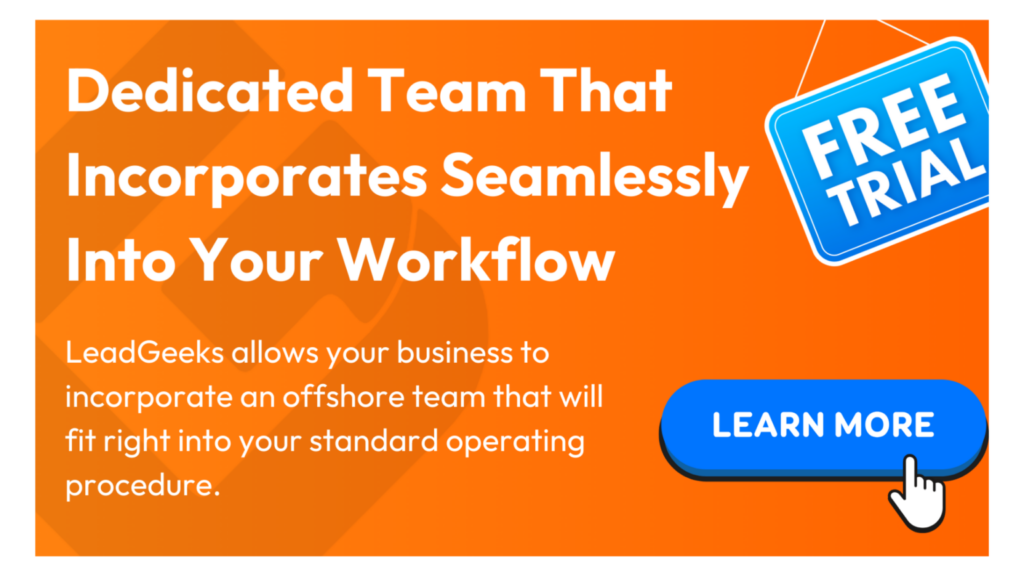In the competitive arena of B2B marketing, the quest for the ideal Business to Business lead source is analogous to striking oil. High-quality leads are the lifeblood of any business, especially when operating in a business-to-business (B2B) landscape. The right lead source can exponentially amplify a company’s growth trajectory, bringing sustainability and profitability within reach.
Nowadays, the number of options for Business to Business lead source can be overwhelming. Tackling all of them can be ineffective for both time and money. In this guide, we aim to look into the essentials of identifying and making the most out of effective B2B lead sources to get you started!
B2B Lead Generation of Today
Today’s B2B lead generation terrain is a complex combination of approaches where digital innovation intertwines with the traditional. Face-to-face interactions at trade shows and networking events continue to hold their ground, while digital tactics, such as content marketing and Search Engine Optimization (SEO), are not far behind. These methods offers a dynamic environment for businesses to explore and exploit.
Yet, understanding the nuances of these lead sources is important to get the best use out of them. Face-to-face approach can have a high chance of conversion, but they may also require higher costs and often longer lead times. On the flip side, digital strategies allows your efforts to be broader, scalable and trackable, but its success depend on how well you can navigate and make use of data.
So, which B2B lead source should you be focusing on first? Lets explore each of the best B2B lead sources of today in the next section.
B2B Lead Sources in 2024
Industry Events and Trade Shows
Despite the digital wave, industry trade shows, conferences, and networking events continue to be gold mines as a Business to Business lead source. Having face-to-face conversations allows for real-time engagement, which gives businesses an opportunity to showcase their products or services to a targeted audience.
Pros:
Direct Interaction
Meeting your potential clients in person, more often than not, leads to strong relationships and more convincing sales pitches. You can make full use of non-verbal communication to instill confidence in your prospects and be more effective in showcasing your products or expertise.
Targeted Audience
As events likely attract professionals with specific interests that are within your relevant industry, lead targeting can be easier and more effective.
Brand Visibility
Even if by the off-chance that you did not manage to generate hot leads during your visit, exhibiting at events by itself also already increases brand awareness within your industry. Mingling and having interpersonal discussions with people in your industry can reinforce your brand to stay top-of-mind for your prospects.
Immediate Feedback
One of the most effective ways to improve your solutions is to have input from clients or potential clients. Having direct demonstrations allow for instant feedback from potential clients to address questions or concerns. This allows your business to tackle missed pain points and even inspire further upgrades to your offer.
Before you start looking into what’s the next big tradeshow your business can go to right away, there’s also a number of cons to consider.
Cons:
Cost
Attending or exhibiting at events can be expensive, considering travel, accommodation, booth setup, and materials. Other than the material resource, human resource also needs to be considered. Medium to Large Enterprises can manage to specially hire, train and fund representatives for this venture, but small and new businesses will struggle in allocating resources for this.
Time-Consuming
Preparation and participation in events require a significant time investment. Some of these time investment includes training, preparing product for demonstration, and promotional materials.
Measuring ROI (Return on Investment)
Being at an industry event does not automatically mean that you will meet clients. They may look into your products or services, but it’s ultimately your offer’s value that they are looking for. This can make it challenging to directly attribute sales or opportunities to event participation and calculate ROI.
Limited Reach
You can only manage to meet, talk and pitch your offer to a considerably limited number of people. Making good use of your time by preparing ahead on who to approach is going to be crucial.
Digital Content and SEO
Content is king in the digital age, and its throne is supported by the pillars of SEO. B2B marketers leveraging high-quality, valuable content can establish thought leadership, drawing organic traffic to their websites. Incorporating SEO best practices ensures that this content reaches the right eyes at the right time.
Pros:
Cost-Effective
With proper execution, SEO and content marketing can generate leads at a lower cost than an eye-to-eye approach. This lowered cost can be in the form of more quality leads generated as it allows for wider, targeted reach.
Long-Term Benefits
Once a content that’s optimized with good SEO have been created, it will passively continue to attract leads. Having evergreen content your business to reap the rewards without any further investment unless the content needs to be updated.
Measurable
Many digital platforms that support content marketing also provides data analytics on how your digital marketing efforts are going. With these analytics, businesses can track visits, engagement, and conversion rates more precisely. This also allows businesses to optimize further if there’s any gaps that can be improved in their SEO.
Flexibility
Information gets updated every single day. Making your target audience see you as a thought leader in the industry can do wonders to your business’ credibility. Digital content offers this flexibility as each content can be updated and optimized as needed to maintain relevance and effectiveness.
Seeing the pros above, it’s no wonder that many started to lean towards digital efforts. However, it’s not all sunshine and rainbows. To make Digital Content and SEO work, there are some hurdles that needs to be considered.
Cons:
Time to See Results
In order for your content to be considered relevant by search engines, they need to be given time to crawl through your content. In addition to this, the content needs to be actively bringing traffic before any results can be seen. SEO is a long-term strategy and it may take months to rank well and see significant traffic.
Technical Complexity
While anyone can learn the process of making SEO-friendly content, keeping up can be even more difficult. Search engine algorithms often receive updates that can be complex. Continuous learning and adjustment of how SEO is optimized is necessary in order to stay relevant.
Competition
If something is lucrative, it’s very likely to be used by many. The same goes for Digital Content and SEO. Competitors often already got a head start in ranking at SERP (Search Engine Results Page). This turn high-value keywords to be extremely competitive, making it difficult to achieve top rankings. Making it through as a new business, therefore, need to be able to find relevant, lower competition keywords that are high in search volume in order to succeed.
Constant Need for Content
Search engines have the tendency to give information from websites that provides consistently relevant and high-quality content. While this goes without saying, this means that to remain effective, content marketing requires the constant production of high-quality, valuable content. This can also affect cost, as you may want to hire and train someone specifically for this role.
Linkedin as Social Media
When it comes to using social media as a Business to Business lead source, LinkedIn stands out as a powerhouse for B2B leads. Known as a gathering place for professionals, it offers invaluable opportunities for networking, sharing content, and targeted advertising.
Pros:
Precise Targeting
LinkedIn’s advertising and search capabilities allow for very specific targeting options based on professional criteria.
Builds Credibility
Linkedin is often used by professionals to look into insights within their industry. This can be an effective tool for businesses to improve brand awareness, as sharing insightful content on LinkedIn establishes businesses as an industry thought leader.
Nurtures Relationships
Linkedin comes with a range of filters to search for specific companies or individuals to reach out to (which can be even more in-depth with their Sales Navigator feature). Making full use of the information from this search allows companies to engage and build long-term relationships with prospects.
Cons:
Pay-to-Play Aspect
Some of LinkedIn’s most effective features for lead generation (such as the aforementioned Sales Navigator) may require payment.
High Competition
As with digital content, many companies are also looking for attention on LinkedIn. Standing out will require a well-crafted strategy and high-quality content.
Slow Building Process
As with digital content and SEO, building a significant LinkedIn presence can take time and may not yield immediate results.
Outbound Campaigns
If inbound source of leads does not fit with your objectives, then outbound might be where you want to also focus on. Outbound campaigns allows you to be more active in the process of engaging potential clients by reaching out to them first either through Linkedin InMail or email campaigns.
Pros:
Proactive Outreach
As mentioned above, this approach allows businesses to actively reach out to potential clients rather than waiting for them to show interest first. This can be highly effective if the prospect have shown thoughts about using solutions like the one your business offers but are not aware of you yet.
Highly Targeted
Nowadays effective outbound campaigns require a targeted approach. By gathering behavior data through their social media or with the help of AI technologies, a highly relevant message can be tailored to address their specific needs and pain points.
Highly Measurable
Through compiling data such as open-rate, response-rate and click-rate, outbound campaigns can be measurable and be improved and optimized over time.
While it’s one of the least cost-heavy resource wise, it has some considerable hurdles as well. Lets address the elephant in the room, shall we?
Cons:
High Initial Rejection Rate
Not a lot of people are fond of being sent promotional messages. Cold outreach often results in high levels of initial rejection or indifference, which can be discouraging (See here for our tips on avoiding this!).
Resource-Intensive
With having a targeted approach comes the significant time and effort required in the process of gathering data, list-building, crafting messages or scripts, and executing the campaigns.
Regulation and Compliance
To discourage mass emailing to unrelated parties, various regulations (such as CAN-SPAM and GDPR) restrict unsolicited outreach. This means executing outbound efforts require careful preparation to stay compliant to the regulations in each region.
Potential Brand Risk
If done poorly, outbound campaigns can annoy potential clients and even harm the perception of your brand. People hate being treated as just another number in a statistic. A deep research into each prospect is necessary so they know that you’re actually approaching them and not send the same email to another 100 people.
Referral
If your business have grown well and you have a established a strong relationship with your existing clients, they can be a great source for leads as well. Of course, while ideally you want clients to do it voluntarily, giving incentives such as a discount on the next contract or purchase may be what they need to recommend you to their peers.
Pros:
High Trust Level
Leads coming through referrals inherently trust you more as they were recommended by someone they know.
Better Conversion Rates
As the information related to your business is from a source they trust, referral leads typically have higher conversion rates compared to leads obtained through other sources.
Cost-Effective
Since it makes use of your existing network, referral marketing often requires less investment than other lead generation strategies.
Cons:
Dependence on Third Parties
Your lead flow relies on the willingness and ability of others to recommend your services, which may not always be consistent.
Risk of Misalignment
As they say, no one knows your business more than you do. There will always be a risk that referrals may not be perfectly aligned with your ideal customer profile. This means that more effort may be required to qualify the leads before proceeding any further.
So, Which Lead Source to Prioritize?
At the end of the day, it’s depends on what your current business targets and goals are. All of the B2B Lead Source here are effective in their own way and can be adapted according to your needs. Here are some suggestions of when you would like to use a certain lead source:
- Industry and Tradeshows: If your goal is direct connections and expanding your network fast
- Digital Content, SEO and Social Media: If your target is building brand awareness
- Outbound Campaigns: If your target is filling your pipeline as your inbound campaigns are on progress
- Referral: Once you have a good number of loyal customers
Evaluating Your Lead Generation Strategy
Of course, effective B2B lead generation isn’t about settling for just any source. Once you have launched your efforts to the sources above, you need to evaluate them. Do they align with your business objectives and audience needs? Here are some questions to consider:
- How well does the lead source reach my target audience?
- Did I get high-quality and relevant leads from this source?
- What is the potential return on investment (ROI) from this source?
- How much time and resources do you need to be effective?
Answering these questions will help in tailoring a lead generation strategy that not only resonates with your target demographic but also drives sustainable business growth.
At the epicenter of a successful B2B lead generation strategy is continuous evaluation and adaptation. The landscape changes rapidly, and what worked yesterday might not be as effective tomorrow. Regular analysis and refinement of your lead sources and methods will ensure that your business stays ahead in the game.
Ready to Generate Leads?
Identifying and tapping into the right Business to Business lead source is a critical endeavor for any business looking to thrive. By making good use out of lead sources that fit your business and continuously evaluating your lead generation strategies, you can build a robust pipeline that drives substantial business growth.
Find the post resourceful so far? Looking to read more topics like this? We cover more insight on B2B Lead Generation process in our blog! Click here for more post like this!















Leave a Reply